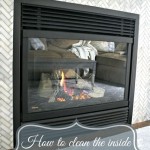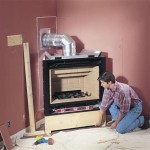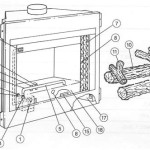Fireplace Soot Cleaner: Understanding, Selecting, and Utilizing for Optimal Fireplace Maintenance
Fireplaces offer warmth and ambiance to homes, but their use inevitably leads to the accumulation of soot. Soot, a byproduct of incomplete combustion, can pose several problems. It reduces the efficiency of the fireplace, increases the risk of chimney fires, and detracts from the aesthetic appeal of the firebox. Therefore, regular cleaning and maintenance using a suitable fireplace soot cleaner are crucial. This article provides a comprehensive overview of fireplace soot cleaners, including their types, selection criteria, application methods, and safety considerations.
Understanding Soot Formation and its implications
Soot is primarily composed of carbon particles produced when wood, coal, or other fuels are burned incompletely. This incomplete combustion occurs when there is insufficient oxygen available during the burning process, leading to the formation of unburned carbon. The resulting soot manifests as a dark, oily, or flaky residue that adheres to the inner surfaces of the fireplace and chimney. The composition of soot can vary depending on the fuel type, burning conditions, and the presence of other substances in the fuel.
The accumulation of soot has several detrimental effects. First, it acts as an insulator, reducing the fireplace's ability to radiate heat effectively. This can lead to decreased heating efficiency and increased fuel consumption. Second, soot is highly flammable. Over time, the buildup of soot within the chimney can create a significant fire hazard. A chimney fire can spread rapidly, posing a serious threat to the safety of the home and its occupants. Third, the presence of soot can contribute to indoor air pollution. Soot particles can become airborne and inhaled, potentially exacerbating respiratory problems and negatively impacting overall air quality.
Furthermore, the aesthetic impact of soot is considerable. A heavily sooted fireplace appears dirty and unkempt, detracting from the visual appeal of the room. Removing soot enhances the overall look and feel of the fireplace, restoring its appearance.
Types of Fireplace Soot Cleaners
Several types of fireplace soot cleaners are available, each with its own characteristics, application methods, and effectiveness. Choosing the right type depends on the severity of the soot buildup, the type of fireplace, and personal preferences.
Chemical Chimney Sweeps: These products, typically in powder or liquid form, contain chemical catalysts that alter the composition of soot, making it easier to remove or causing it to burn away more efficiently during subsequent fires. They are often added to the fire during regular use and are designed to help prevent soot buildup and loosen existing deposits. However, they are not a substitute for professional chimney cleaning, especially in cases of heavy soot accumulation.
Spray-On Soot Removers: These cleaners are designed to be sprayed directly onto the sooted surfaces. They often contain solvents and detergents that dissolve or loosen the soot, allowing it to be wiped or brushed away. These are particularly useful for cleaning the firebox and other readily accessible areas. They are generally effective for removing moderate soot deposits but may require multiple applications for heavy buildup.
Creosote Removers: Creosote is a tar-like substance that forms in chimneys when burning wood. It is even more flammable and difficult to remove than soot. Creosote removers often contain specialized chemicals designed to break down the creosote into a more manageable form. Some chemical chimney sweeps also contain creosote-reducing agents.
Natural Cleaners: Some homeowners prefer to use natural cleaning agents, such as vinegar, baking soda, or borax, to remove soot. These options are generally less harsh than chemical cleaners but may require more elbow grease and multiple applications. They are best suited for light soot deposits and regular maintenance cleaning.
Professional Cleaning Services: For heavily sooted fireplaces or complex chimney systems, professional chimney cleaning services are recommended. These professionals have the expertise and equipment to safely and effectively remove soot, creosote, and other debris from the entire chimney system. They also inspect the chimney for any structural damage or other issues that may require attention.
Selecting the Right Fireplace Soot Cleaner
Choosing the appropriate fireplace soot cleaner involves considering several factors to ensure effectiveness and safety. Key considerations include:
Type of Fireplace: Different types of fireplaces, such as wood-burning, gas, or electric, may require different cleaning approaches. Verify that the chosen cleaner is compatible with the specific fireplace type. Some cleaners may be corrosive to certain materials used in gas fireplaces, while others may not be suitable for electric models.
Severity of Soot Buildup: The extent of soot accumulation will influence the type of cleaner needed. For light soot deposits, a spray-on soot remover or natural cleaner may suffice. For heavy buildup, a chemical chimney sweep or professional cleaning service may be necessary.
Safety Considerations: Always prioritize safety when selecting and using fireplace soot cleaners. Read and follow the manufacturer's instructions carefully. Wear appropriate protective gear, such as gloves, eye protection, and a respirator, to avoid skin contact, eye irritation, and inhalation of fumes. Ensure adequate ventilation in the area being cleaned to prevent the buildup of hazardous vapors.
Ingredients and Environmental Impact: Review the ingredient list of the cleaner to assess its potential environmental impact. Opt for cleaners that are biodegradable, non-toxic, and environmentally friendly whenever possible. Avoid cleaners containing harsh chemicals that can harm the environment or pose health risks.
User Reviews and Recommendations: Research online reviews and seek recommendations from other fireplace owners or professionals. This can provide valuable insights into the effectiveness and safety of different cleaners.
Cost-Effectiveness: Compare the cost of different cleaners and consider their value proposition. While some cleaners may be more expensive upfront, they may offer superior performance or require less frequent application. Consider the long-term cost savings associated with preventing chimney fires and maintaining efficient heating performance.
Applying Fireplace Soot Cleaner Safely and Effectively
Proper application of fireplace soot cleaner is essential to achieve optimal results and ensure safety. The following steps outline a general procedure for applying most types of cleaners:
Preparation: Begin by preparing the area to be cleaned. Remove any ash or loose debris from the firebox and chimney. Cover the surrounding floor and furniture with drop cloths to protect them from spills or splatters. Ensure adequate ventilation by opening windows or doors.
Protective Gear: Wear appropriate protective gear, including gloves, eye protection, and a respirator or dust mask. This will protect the skin, eyes, and respiratory system from irritation or exposure to hazardous chemicals.
Application: Follow the manufacturer's instructions for applying the specific cleaner. For spray-on soot removers, spray the cleaner evenly onto the sooted surfaces, ensuring complete coverage. Allow the cleaner to dwell for the recommended amount of time, typically a few minutes. For chemical chimney sweeps, add the cleaner to the fire according to the manufacturer's instructions.
Cleaning: After the dwell time, use a brush, sponge, or cloth to scrub the sooted surfaces. For stubborn soot deposits, a scraper or putty knife may be necessary. Rinse the cleaned surfaces with clean water and allow them to dry completely.
Ventilation: Maintain adequate ventilation throughout the cleaning process and for several hours afterward to allow any remaining fumes to dissipate.
Disposal: Dispose of used cleaning materials, such as rags, sponges, and brushes, properly. Follow local regulations for disposing of hazardous waste.
Inspection: After cleaning, inspect the fireplace and chimney for any signs of damage or deterioration. Address any issues promptly to prevent further problems.
Safety Precautions and Best Practices
Fireplace soot cleaners can contain hazardous chemicals that pose risks if not handled properly. Adhering to the following safety precautions and best practices is crucial:
Read the Label: Always read and follow the manufacturer's instructions carefully before using any fireplace soot cleaner. Pay attention to warnings, precautions, and first aid information.
Ventilation: Ensure adequate ventilation in the area being cleaned. Open windows and doors or use a fan to circulate air. Avoid breathing in fumes or vapors.
Protective Gear: Wear appropriate protective gear, including gloves, eye protection, and a respirator or dust mask. This will protect the skin, eyes, and respiratory system from irritation or exposure to hazardous chemicals.
Storage: Store fireplace soot cleaners in a cool, dry place, away from children and pets. Keep the containers tightly closed and clearly labeled.
First Aid: In case of skin contact, wash the affected area thoroughly with soap and water. In case of eye contact, flush the eyes with water for at least 15 minutes. If swallowed, seek medical attention immediately. Do not induce vomiting unless directed by a medical professional.
Professional Assistance: For heavily sooted fireplaces or complex chimney systems, consider hiring a professional chimney cleaner. These professionals have the expertise and equipment to safely and effectively remove soot, creosote, and other debris.
Regular Maintenance: Regular cleaning and maintenance are essential for preventing soot buildup and maintaining a safe and efficient fireplace. Schedule regular chimney inspections and cleaning, especially if the fireplace is used frequently.

Clean Soot Fireplace From Stone Furnace Oil Leaks Diesel Spills Gas Remediation

Paint N L Fireplace Cleaner Chimneysaver

Best Way To Clean A Fireplace Stacy Risenmay

How To Clean Soot From A Gas Log Set Vertical Chimney Care

Remove Soot From Fireplace Tips For Cleaning Chimney

How To Clean A Brick Fireplace Before Painting

How To Clean A Fireplace Homeright

Soot Cleaning With Sdy White Cleans Fireplaces Stoves Stonework Gas Fireplace Glass And More

How To Clean A Neglected Stone Fireplace Georgian Cottage

Removing Soot Stains From Bricks And Stone Chimneys Com
Related Posts








